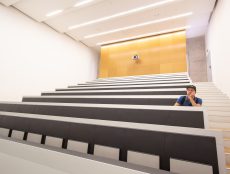
If you search ‘personalized learning’ today, you’ll likely find a good deal of thought leadership-type articles on its merits. Even publications as rigorous as The Hechinger Report have unblinkingly praised its merits. There is currently no shortage of educators either trying personalized learning or willing to do so.
But among edtech leaders, some have grown skeptical of its uses and the way it is implemented today. Larry Berger, CEO of Amplify, has recently voiced a sobering argument about its shortcomings. In February, Education Week blogger Rick Hess published his written comments in a post.
“The Map Doesn’t Exist”
His argument and summary of personalized learning, reads, “You start with a map of all the things that kids need to learn.”
“Then you measure the kids so that you can place each kid on the map in just the spot where they know everything behind them, and in front of them is what they should learn next.”
“Then you assemble a vast library of learning objects and ask an algorithm to sort through it to find the optimal learning object for each kid at that particular moment.”
“Then you make each kid use the learning object. [The more kids use it, the smarter and better it gets.]”
“Here’s the problem: The map doesn’t exist, the measurement is impossible, and we have, collectively, built only 5% of the library.”
In April, Hess published a response letter by Joel Rose, CEO of New Classroom Innovation Partners. This week at the ASU + GSV Summit, the two were joined by Nick Gaehde, president of Lexia Learning, Joel Rose, and Phil Regier, a dean at ASU, along with moderator Phyllis Lockett (Leap Innovations co-founder) for a panel discussion on personalized learning.
The ASU + GSV Summit Panel on Personalized Learning
Berger began. From an engineering point of view, he argued, personalized learning seems like a great idea. Classrooms, after all, aren’t great systems. “You’ve got 30 parallel processing kids out there and they each can think about things at different levels,” Berger said. “And you’ve got one transmitter that is not parallel processing capable.” (That would be the teacher.)
“So, the engineer says, this is great. This is something we can fix. We can replace that one transmitter with a range of parallel processing experiences that can solve that network diagram and make it rational. That’s attractive at a structural level. The computer can multitask, the kids need multitasking, let’s put it there.”
“There’s a pedagogical and personal thing that comes along to support that view. A lot of educational research says that one-on-one tutoring is kind of the best thing we have if we want to make a big gain for a kid. There’s nothing that has outperformed that as a teaching model.”
“So if you put those two together—the engineering thing that makes sense, the computer can get close to a one-to-one teaching model, and one-to-one feels right. Our best experiences are sort of like that.”
So personalized learning sounds like it would make a lot of sense. Berger, after all, has skin in this game. Amplify offers personalized learning curriculum and assessment options. But there’s a problem. Few people, according to Berger, have been able to make a personalized model work well.
“What’s going on is not simply the matching of teaching and level; it’s an adult that that student wants to impress and understand, and it’s an adult that’s understanding that kid. So the engineering diagram of personalized learning looks better, but something can get lost in that shuffle.”
Berger was outnumbered by his panelists, who were largely pro-PL. Various familiar responses met his initial comments. Nick Gaehde said, “I think the personalization of the curriculum allows the student to do some things they would never do without it. It allows them to take some risks and as we all know, especially when you’re getting into upper elementary school and middle school, the number one job is ‘don’t get embarrassed.’ So without that technology and 1-1 curriculum, students aren’t going to take those risks without that environment that technology allows for them.”
Many other familiar points followed. For example, personalized learning has shown itself to be very effective in K-8 math and early literacy. But that’s more or less its extent.d
PL is still a very new technology. Many are keen to tout its virtues, but few have been able to display hard results, especially outside of the two areas of education mentioned above.







[…] The conclusions drawn from this study are relevant for research in adaptive personalized reading courseware. But they also reverberate more broadly. Many education researchers consider efficacy research a main bellwether in edtech. […]